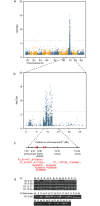MYB1 transcription factor is a candidate responsible for red root skin in radish (Raphanus sativus L.)
- PMID: 30240413
- PMCID: PMC6150496
- DOI: 10.1371/journal.pone.0204241
MYB1 transcription factor is a candidate responsible for red root skin in radish (Raphanus sativus L.)
Abstract
Root skin color is one of the economically important traits in radish (Raphanus sativus), and the pigmentation in red skin varieties is largely attributable to anthocyanin accumulation. Pelargonidin was found as a major anthocyanin pigment accumulated in the sub-epidermal layer of red radish roots. In the 20 F2 population generated from the F1 with red root skins, root skins with red and white colors segregated in a 3:1 ratio. Additionally, a test cross between a red F3 individual and a white skin individual gave rise to 1:1 segregation of red and white, indicating that the root skin color of radish is determined by a single locus and red color is dominant over white. We performed association mapping for root skin color using SNPs obtained from RNA-seq analysis. Segregation analysis on the 152 F3 test-cross population revealed an RsMyb1 transcription factor as a candidate gene to determine root skin color. A PCR marker based on the polymorphism within 2 kb of RsMyb1 was developed and tested on 12 and 152 individuals from F2 and F3 test cross populations, respectively, and red and white root skin colors were completely distinguished corresponding to the genotypes. Expression levels of RsMyb1 in red or purple root cultivars were significantly higher than in white root cultivars. These findings suggest that RsMyb1 is a crucial determinant for anthocyanin biosynthesis in radish roots, and the molecular marker developed in this study will be useful for marker-assisted selection for red skin individuals at early seedling stages.
Conflict of interest statement
The authors have declared that no competing interests exist.
Figures




References
-
- Harborne JB, Paxman GJ. Genetics of anthocyanin product in the radish. Heredity. 1964;19: 505–506. - PubMed
-
- Vivarelli F, Canistro D, Sapone A, De Nicola GR, Babot Marquillas C, Iori R, Antonazzo IC, et al. Raphanus sativus cv. Sango sprout juice decreases diet-induced obesity in sprague dawley rats and ameliorates related disorders. PLoS One 2016; 11:e0150913 10.1371/journal.pone.0150913 - DOI - PMC - PubMed
-
- Yarnell SH. Cytogenetics of the vegetable crops. II. Crucifers. Bot Rev. 1956; 22:81–166.
Publication types
MeSH terms
Substances
LinkOut - more resources
Full Text Sources
Other Literature Sources
Miscellaneous

